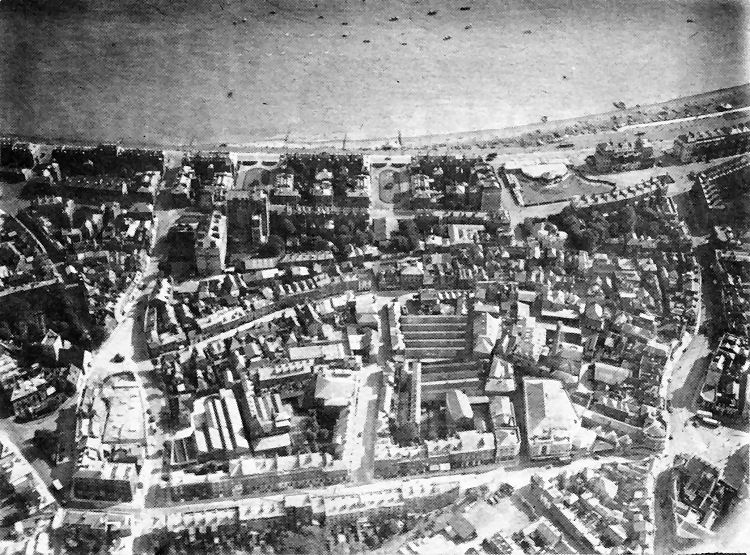Page Updated:- Sunday, 07 March, 2021. |
|||||
 Published in the South Kent Gazette, 30 July, 1980. A PERAMBULATION OF THE TOWN, PORT AND FORTRESS. PART 100.
KING’S ARMS LIBRARY It is difficult to disassociate Dover historically as a seaside town from the King’s Arms Library in New Bridge, but Dover was a fashionable bathing place some eight or nine years before the library was built so that when its book saloon was opened by Mr William Batcheller and its Assembly Rooms made available for balls and parties, the establishment was much appreciated. Before the library was built the top corner of Snargate Street and that part of New Bridge were occupied by premises belonging to Mr P. J. Hillier, a well known builder of that period. Mr Hillier sold the old house and premises to Mr Batcheller in 1825, who then built the library on the site, giving it the name of “The King’s Arms," George IV then being King. The establishment was carried on by Mr Batcheller for about forty years. It was there that he established, on 16th November 1833, the "Dover Telegraph“ which, although not the first Dover newspaper, had one of the longest publication runs, extending into the 1920s. Mr Batcheller was a keen antiquarian and wrote a valuable history of Dover and an attractive Dover Guide which ran into many editions. The premises continued as a library and stationery establishment for about 80 years, later proprietors being Messrs Harvey and Hemin, Cuff Brothers, Dawson and Son and Barlett and Son. The part which was originally used as an assembly room in turn housed several Dover organisations including the Granville Club, from the early 1880s until 1906 and later the Dover Commercial Club prior to its move to Waterloo Crescent in December 1931. Part of the publishing department on the ground floor, next to Northampton Street, became a Dover office of the Prudential Assurance Company and later was turned into a shop. For many years until recent times the block where the library was located was the premises of the Hotel de France, being demolished eventually in order to link up the Town wall Street and York Street dual-carriageways.
JOINT IMPROVEMENT The houses on the eastern side of New Bridge date from 1840, In the Bill introduced to Parliament for widening Bench Street, provision was made for removing two houses in New Bridge, at the corner of Town wall Street, and immediately after the Bench Street improvement was finished the Harbour Board and the Paving Commissioners co-operated for the widening of New Bridge. The two houses at the time the bridge was built, in 1800, were the property of Mr Thomas Pattenden whose valuable diary of the period is in the Dover muniment collection which used to be housed at the town hall. He lived in one house and let the other as a lodging for seaside visitors. In 1840 permission was given by the Paving Commissioners to take down the parapet on the east side of the bridge, and houses were built from the Townwall Street comer. Prom them a blank wall was continued to houses in Camden Crescent, which were built at the same time, Dr Sankey building the first two and residing in the first.

A bird’s eye view of Dover in the early 1930s from a position over Pencester Gardens. Running across the foreground Is Castle Street with the junction of Castle Hill Road and Ashen Tree Lane on the left and the Market Square on the right. Running across the centre of the picture is St. James’ Street with Russell Street and Fector’s Place providing the link with Castle Street. A variety of, industrial premises behind Castle Street include the Phoenix Brewery at the rear of the Granada cinema (now the ABC cinema). The British Oxygen Company’s premises with malthouse to the rear, near the corner of Maison Dieu Road and Castle Street, where the MFI building Is now being erected, and Leney’s mineral water works in Russell Street. Running parallel with the Marine Parade Is Liverpool Street with Granville Gardens and the Grand Hotel at one end and the Burlington Hotel, at the Woolcomber Street junction, the other end.

Above shown are three advertisements in connection with the old Dover Fair held at the tea gardens and bowling green of the Black Horse, Charlton Green.

The masthead of the first copy of the Dover Telegraph published at the King's Arms Library on 16th November 1833.
|
|||||
|
If anyone should have any a better picture than any on this page, or think I should add one they have, please email me at the following address:-
|
|||||
| LAST PAGE |
|
MENU PAGE |
|
NEXT PAGE | |